Please scroll to the bottom of the page for the English version.
- 太平洋岸北西沿岸部(ノースウェストコースト)の先住民族アート
- トリンギット族グラスアーティスト プレストン・シングレタリー
- ガラス吹きとノースウェストコーストアートの橋渡しであるのアーティスト
- モダンで美しいカラー×グラス×トリンギットの伝統的なデザインの融合
- 展示会で実際に見たプレストン・シングレタリーのグラスアートたち
- バンクーバーでの生活で得る人生の宝
- プレストン・シングレタリーの数々の賞と栄誉
- ノースウェストコーストのアートで使われるシンボルの意味
- The glass art of the Tlingit artist Preston Singletary, The miracle of encountering him in person
- Indigenous art of the Pacific Northwest Coast
- The glass artist of the Tlingit nation, Preston Singletary
- The life of Preston Singletary
- The artist bridging glassblowing and Northwest Coast art
- The Fusion of Modern Art, Glass, and Tlingit Tradition
- Experiencing Preston Singletary’s Glass Art at an Exhibition
- The numerous awards and honors of Preston Singletary
- The meaning of symbols used in Northwest Coast art
太平洋岸北西沿岸部(ノースウェストコースト)の先住民族アート
バンクーバーで私が出会って夢中になっているのは,太平洋岸北西沿岸部(ノースウェストコースト)の先住民族アートです。「太平洋岸北西地域」とは、北カリフォルニアからカナダ沿岸部を経てアラスカ南部まで続く沿岸地帯です。この地域には様々な先住民族が存在し、それぞれが独自の文化、言語、伝統を持っています。
下記が主な先住民族です。
- コースト・セイッシュ(Coast Salish)
- ハイダ族(Haida)
- トリンギット族(Tlingit)
- ヌートカ族(Nuu-chah-nulth)
- マカ族(Makah)
- クワキウトル族(Kwakwakaʼwakw)
- ヌクサルク族(Nuxalk)
- スクアミッシュ族(Squamish)
- カウィチン族(Cowichan
トリンギット族グラスアーティスト プレストン・シングレタリー
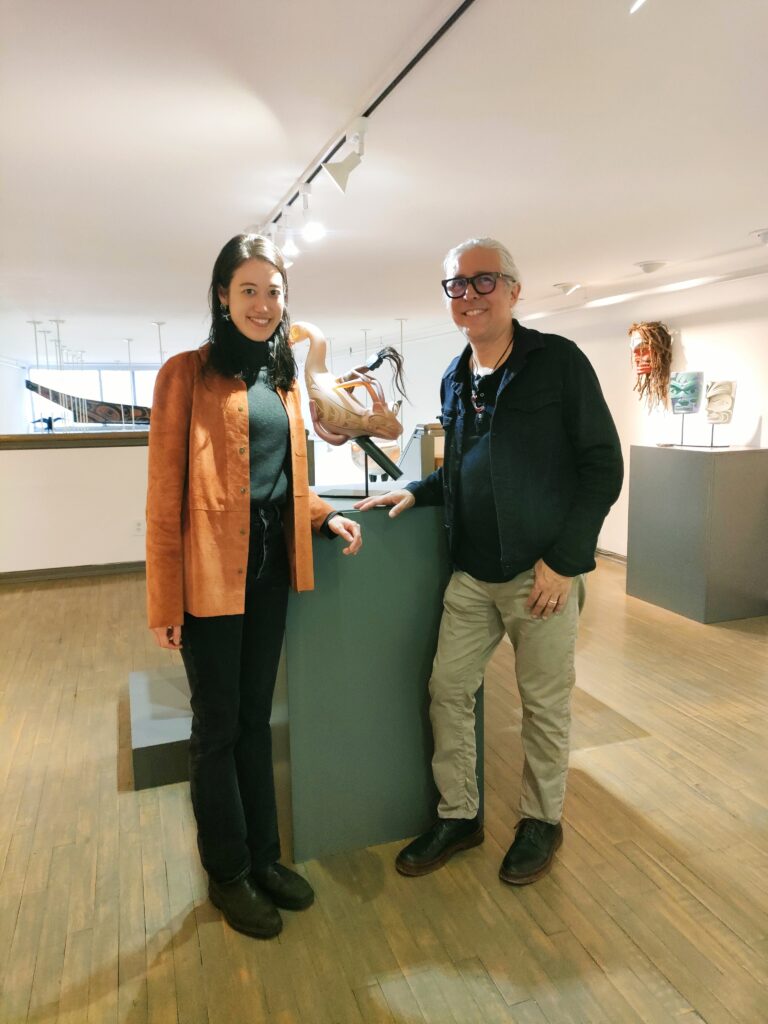
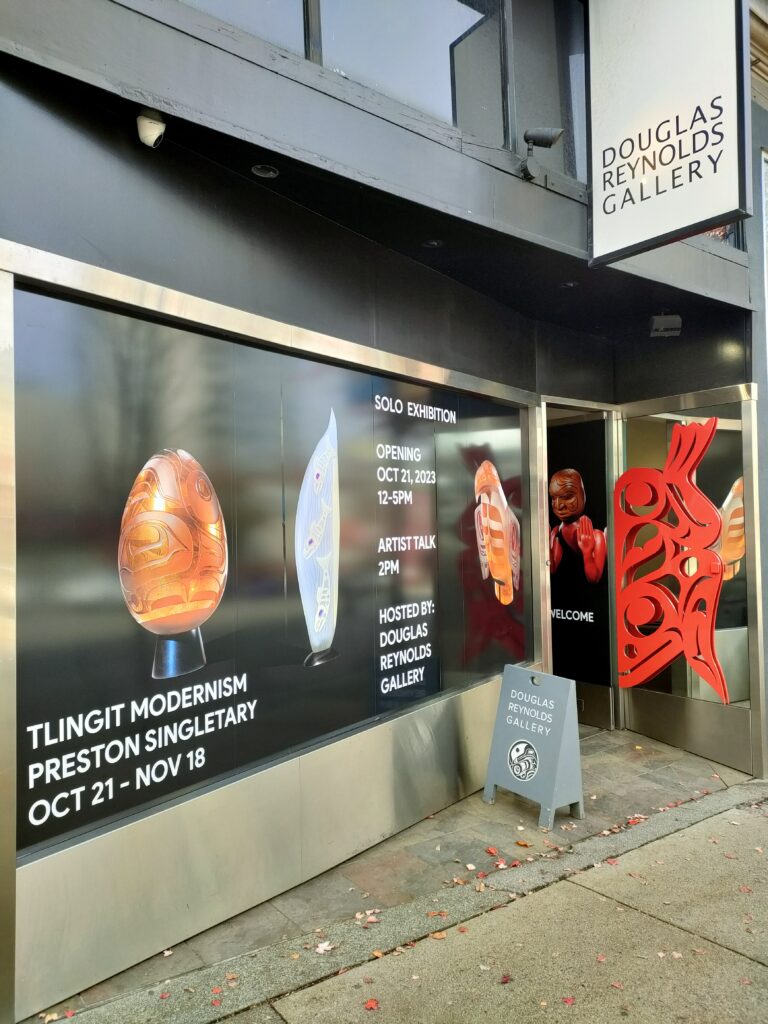
パートナーの仕事の関連で、私はありがたいことに太平洋岸北西沿岸部(ノースウェスト)の先住民族アーティストやアートを知ったり、直に触れる機会に恵まれることがあります。
今回の記事では、トリンギット族グラスアーティスト プレストン・シングレタリーと彼のアートについてご紹介していきます。
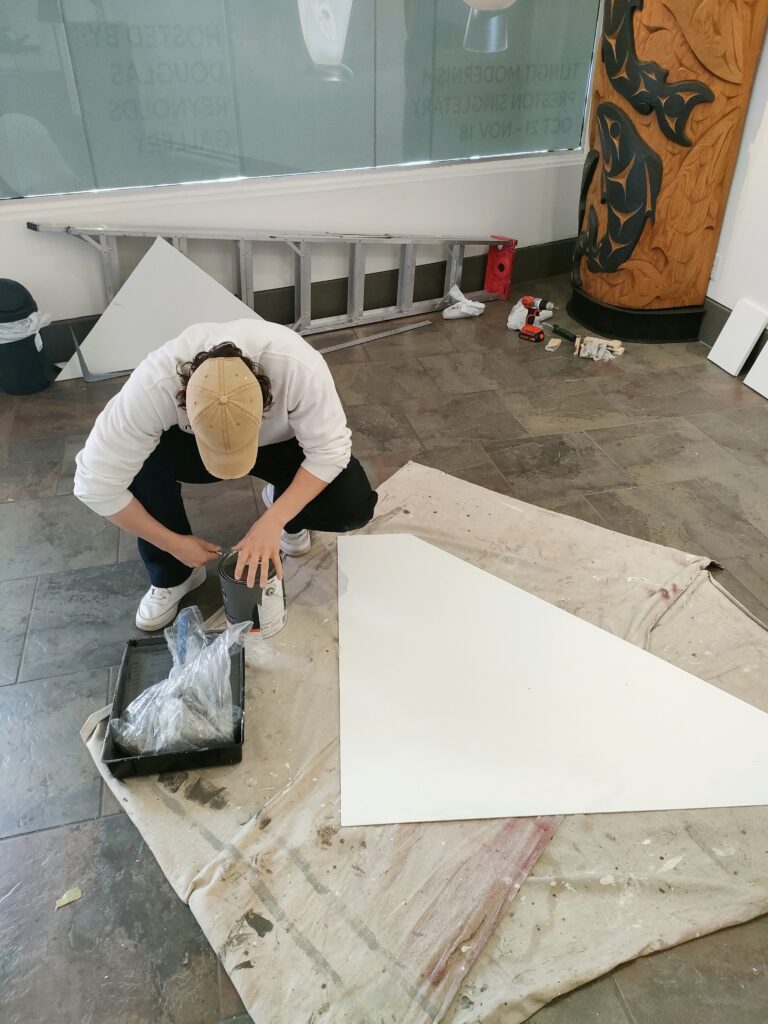
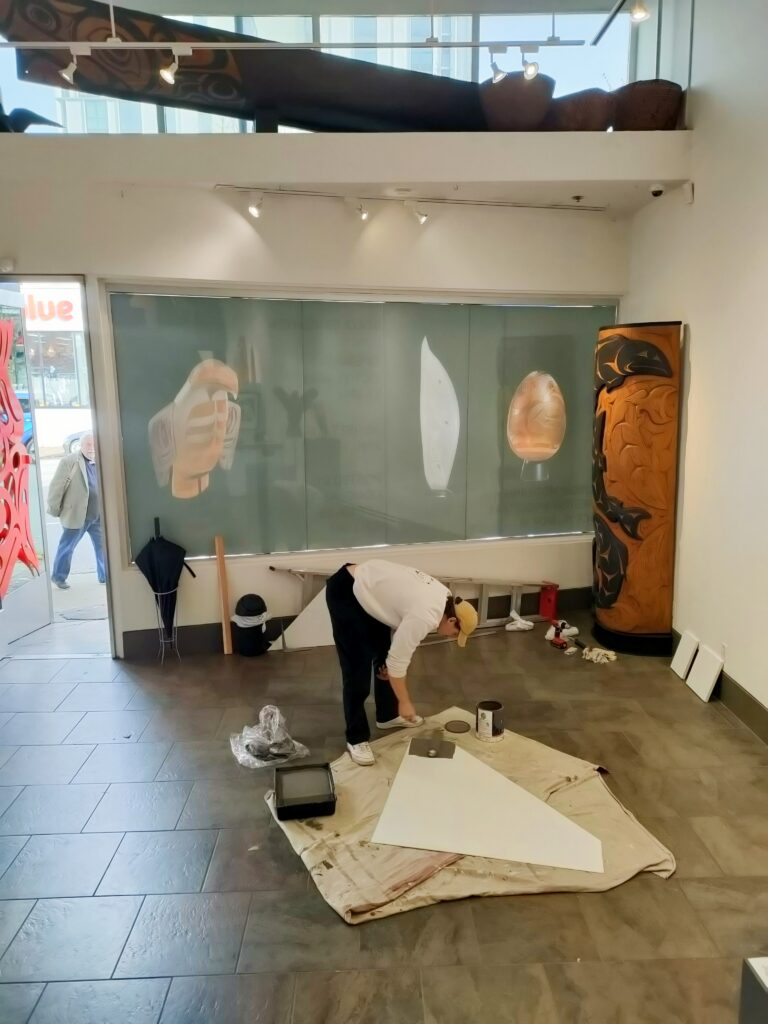
プレストンの展覧会が始まる前日にギャラリーに出向き、奇跡的なタイミングでご本人にお会いすることができました。(上の写真はプレストンの展覧会の準備中の様子)
彼の作品の最も大きな特徴は、ノースウェストコーストのアートでは見られない素材「ガラス」を使用していることです。歴史上、太平洋岸北西沿岸部の先住民族は彼らの住む環境にある自然素材を使ってきました。
現在、その地域のアーティストたちは伝統的な手法に加えて、現代の素材を使用しています。その中でプレストン・シングレタリーは、伝統的な材料である赤や黄のシダーやアワビ、スプルースから離れ、ガラスを用いて自らの伝統を表現する北西海岸のアーティストとして世界的に高い評価を得ているアーティストです。
プレストン・シングレタリーの人生

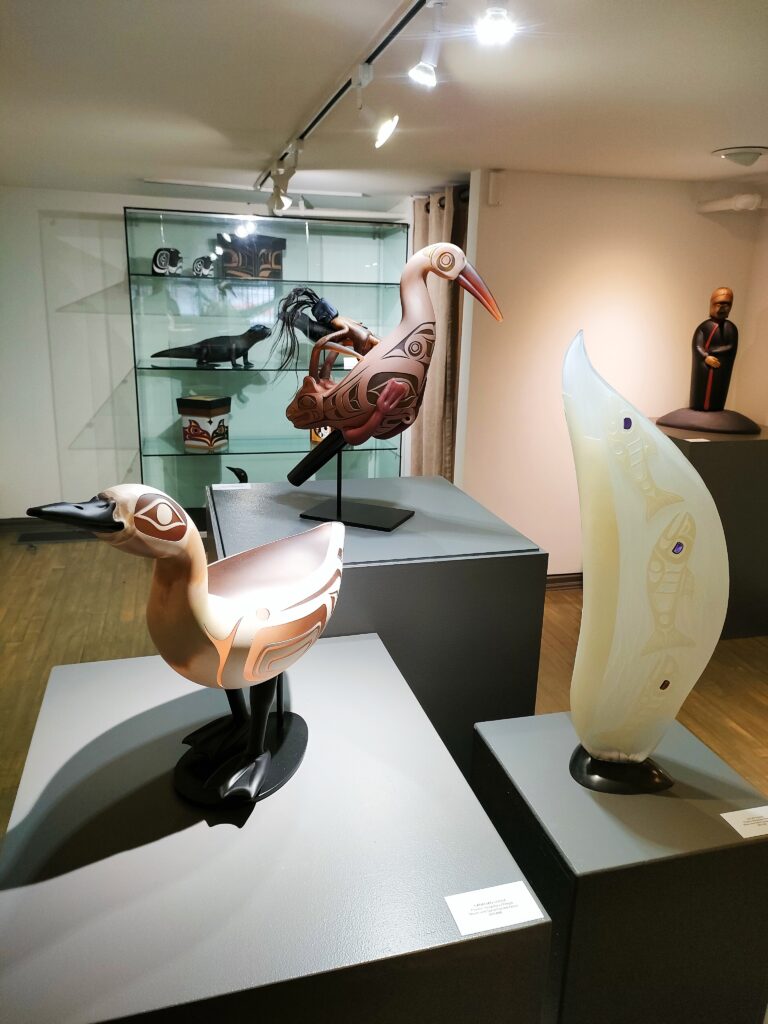
女系家族の中で育った幼少期
プレストン・シングレタリー(アメリカ人 | トリンギット族、1963年生まれ)
彼の幼少期は、女系家族の中で育てられました。プレストンの曾祖母、スージーは、プレストン一家を北西部に中心に据えました。彼女は、大きな変革の時代であった1880年にアラスカのシトカで生まれました。ジョージという男性と結婚することが決められましたが、彼は1918年の製材所の事故で亡くなりました。スージーは彼との間に、プレストンの祖母を含む5人の子供をもうけていました。
その後、彼女はディオニシオという男性と再婚し、1920年代にシアトルに移りました。彼らはさらに3人の子供をもうけます。その中の1人である彼の祖母のリリアンは、母ジーンと叔母アンドリーナ、テレサをほぼ一人で育てました。
叔母アンドリーナはアラスカ先住民のルーツに誇りを持っていました。トリンキッド族の意図的な話し方を確実に把握していました。プレストンは彼女は家族の中で重要な存在と考えています。アンドリーナはプレストンの5人の従兄弟たちの母親であり、何年もの間、楽しい時間を一緒に過ごしました。「8歳のときに一緒にディズニーランドに行った一大ロードトリップは忘れられません」とプレストンは語ります。
またもう1人の叔母であるテレサは筆跡学や数秘術など多くの秘伝的な知識に興味津々な人でした。彼女はプレストンの名前、ミドルネーム、姓に対する数秘術的な分析に基づいて、彼がこの地球上において、人生で、勤勉さの意味を学ぶために生まれてきたと教えてくれたそうです。また、18歳のときには旅をするだろうし、30歳になったら彼の人生が永遠に変わるだろうとも言っていました。
「彼女の予言は当たりました」とプレストンはいっています。
また彼の祖父は海軍の料理長で、いつも出かけていたため、実際にプレストンが会ったのは数回だけだったそう。最終的に祖父はフィリピンに戻り、二度と会うことはなかったそうです。そして彼は1960年代後半に亡くなりました。
「祖母は私たちの家族に親しみを感じ、私に甘えていました。時折、私はそれに少し恥ずかしさを感じることもありましたが、祖母にはそう言えません。特に彼女の家族と私たちの部族のつながりが、最終的に私の生涯の仕事の基盤となることを考えると」とプレストンは語っています。
参考文献「Fusion Notes」
「Fusion Notes」のリンクはこちら https://minormattersbooks.com/products/fusion-notes-by-preston-singletary.
プレストンのオフィシャルWebサイトはリンクはこちら : https://www.prestonsingletary.com/.
高校時代〜卒業後
高校時代には、ガラスアーティストであるポール・マリオニの息子であるダンテ・マリオニと友達になりました。高校を卒業した直後、当時はミュージシャンとしてのキャリアを追求していた プレストンは、ダンテ・マリオニによって、当時のガラス吹きスタジオ「ガラスアイ」で夜間の警備員として働くよう頼まれました。
その後プレストンはすぐに夜間警備員から昼間のシフトへと移り、最終的にスタジオの制作チームの一員となりました。
10年以上の修行時代、名門グラスアート学校「ピルチャック・グラス・スクール」、そしてヨーロッパでガラスの伝統技術を習得
1984年、 プレストンはワシントン州北西部、スタンウッドにある「ピルチャック・グラス・スクール」で初めてのワークショップに参加しました。
そして助手としてガラス吹きの世界に入りガラスアーティスト、ダンテ・マリオーニなどと共に働きながら、ヨーロッパの伝統の技術を習得していきました。さらにイタリアのガラスアート界の巨匠であるリノ・タリアピエトラやピノ・シニョレットなどと共に仕事をする中で、ヴェネツィアのガラス職人の技術も学びました。
1990年代初頭、トリンギット族のテーマを取り入れ始める
ガラスアーティストとしての技術を磨きながら、1990代初頭シングレタリーは伝統的なトリングギットのテーマを作品に取り入れ、彼の今のスタイルを築き始めました。
彼は「1982年にガラスとの仕事を始めたとき、私はこの材料とのつながりがこれほど深くなるとは思っていませんでした。私の作品が新しい目的と方向を持つようになったのは、トリングギット文化のデザインを実験し始めた時でした」と語っています。
プレストンーの多くの作品に見られるフォームラインデザインのスキルは、ノースウェスト・コーストの著名なアーティストとの研究や協力によって得られました。
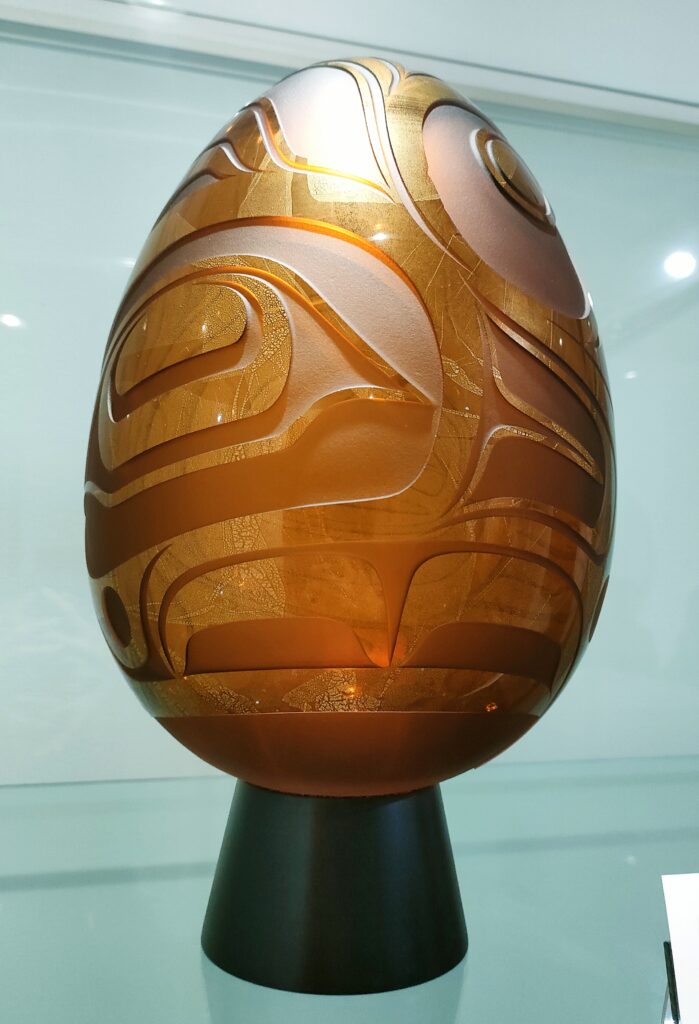
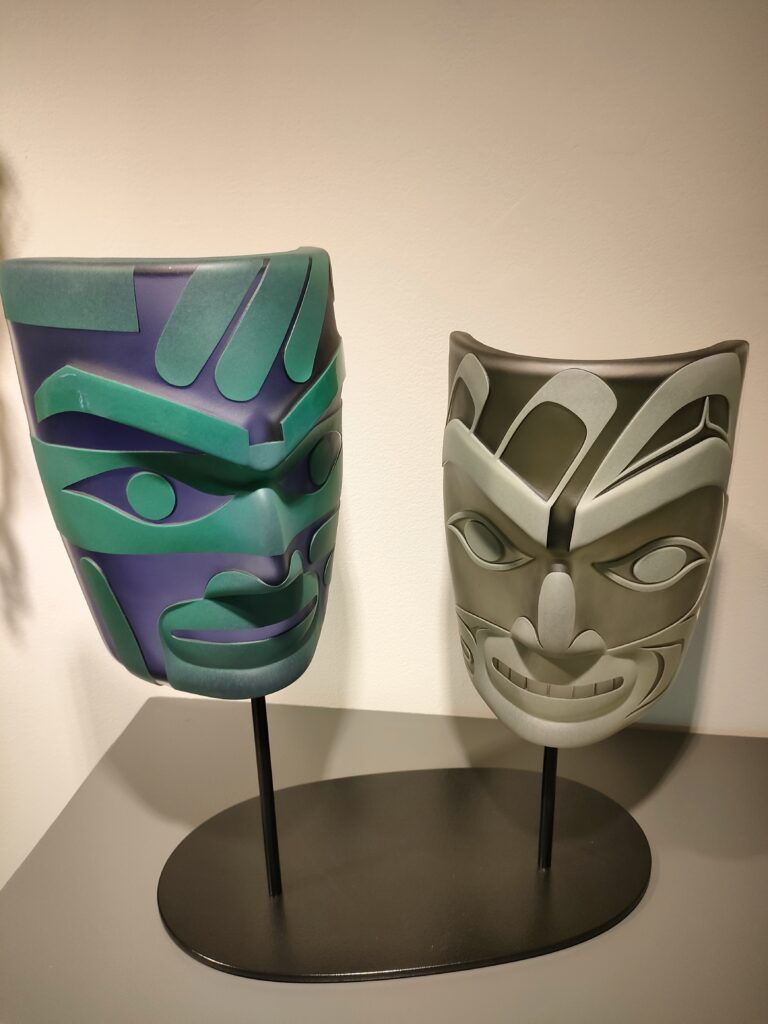

その中でも特に「彫刻家ジョー・デイヴィッドの指導が彼の仕事を新たなレベルに引き上げるのに役立ちました」と彼はいいます。そしてプレストンはジョー・デイヴィッドとコラボレーションして多くの作品を制作しています。上の三枚の写真は彼らがコラボレーションした作品たちの一部です。
(上)Thunderbird Egg
Blown and Sand Carved Glass 13″ H x 7″ diam
(左下)Initiation
Blown and Sand Carved Glass 17 ¾” H x 16″ W x 16″ D
(右下)Water Protector
Blown and Sand Carved Glass 36 ¾” H x 9″ W x 5 ½” D
彼はガラスを家族、社会、文化のルーツと再び繋げ、育った物語を視覚的に表現する芸術的な媒体として捉えました。「先住民の文化は常に前進し、新しい素材に適応していく。ガラスでトリンギットのデザインを表現することは、私にとって次のステップのように感じられました」と彼は述べています。
ガラス吹きとノースウェストコーストアートの橋渡しであるのアーティスト
プレストンは、ガラスの訓練に特化したノースウェストコーストのアーティストとして、現代の媒体と北西海岸のデザインを結ぶアーティストと見なされています。
太平洋北西部は強い先住民の視覚的アイデンティティで知られており、彼の住むシアトルは、20世紀の最高のガラスアーティストのいくつかを輩出しています。プレストンはこれら2つの世界を彼の作品の融合させています。彼はガラスメディアに興味を持つ多くの他の先住民アーティストと協力し、ガラスアートの新たな方向性の可能性を探求しています
プレストンは「他のネイティブアメリカン、ハワイアン、およびオーストラリアのアボリジニアーティストたちとガラスを教えたり協力したりすることを通じて、ガラスが先住民芸術に新たな次元をもたらすことを理解しました。
先住民の芸術的な視点は、土地の古代のコードやシンボルにつながる独自で重要な視覚言語を反映しており、この相互作用は私の作品を形成しインスパイアしました。私の成功が、他の未代表の先住民文化出身のアーティストたちにガラスや他の非伝統的な材料を使用する勇気を与え、私のキャリアが進むにつれてこの領域でのさらなるイノベーションを奨励し続けられることを願っています」と語っています。
モダンで美しいカラー×グラス×トリンギットの伝統的なデザインの融合
彼の作品は、ガラスと、トリンギットの伝統的なデザインやシンボルの2つの要素を融合させ、両方の世界を結ぶフュージョンを生み出しています。
モダンな(虹のような表面、内部で光るライト、エレクトリックブルー、海のようなグリーン)とトリンギットの伝統的なシンボルとシェイプが組み合わされているのが彼の作品の魅力。
プレストンの使命は「伝統的な伝説や象徴を復活させ、物語を語り、古代のビジョンを未来に伝える美しいオブジェクトを創造すること」彼の作品は、現代の素材を使用して伝統的なデザインに新しいエネルギーを注入することで、過去、現在、未来が結びついていると感じる彼の先祖に敬意を表しています。
彼自身について深く知ることで、彼の作品が人々を魅了する理由がよく分かります。
展示会で実際に見たプレストン・シングレタリーのグラスアートたち
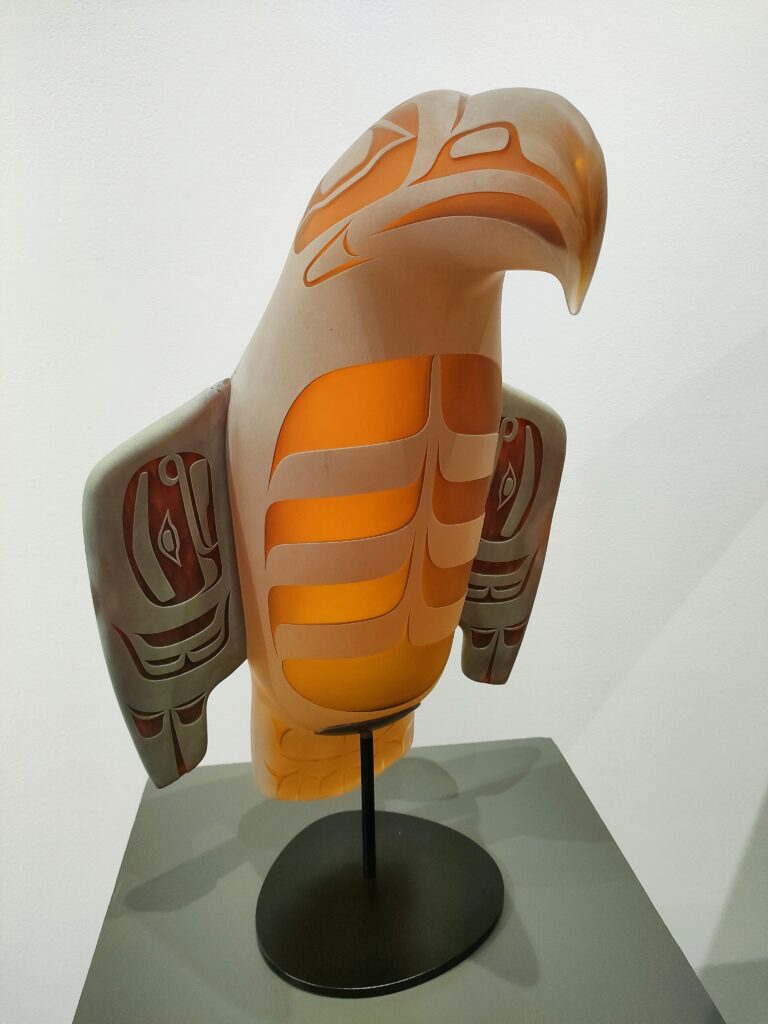
Golden Eagle
Blown and Sand Carved Glass 20 ½” H x 14″ W x 11″ D
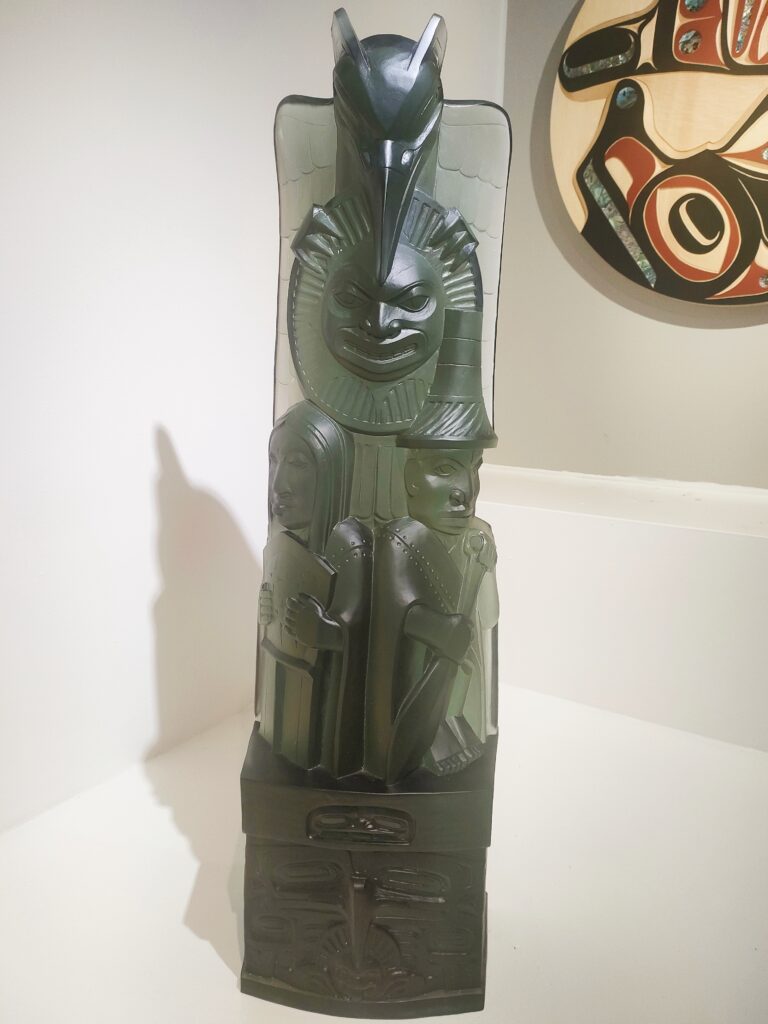

(左)Raven and the Box of Daylight
Cast Lead Crystal 32 ½” H x 8 ½” W x 6″ D
このトーテムポールは、トリンギット族の象徴的な物語「Raven and the Box of Daylight(カラスと昼光の箱)」に基づいています。この物語は、かつて暗闇だった世界にカラスが月、星、太陽を通じて光をもたらすというRavenの物語です。
トーテムポールの頂上には、太陽を抱えるいたずらっぽいカラスがいます。その下には、裕福な男性と彼の娘が昼光の箱の上に立っています。オリジナルの木製トーテムポールはデイビッド・フランクリンによって彫刻されました。
(右)Two Ravens Collaboration with Joe David
Cast Lead Crystal 35 ½” H x 8 ½” W x 9″ D
このトーテムは、トリンギット文化とプレストンの妻の出身国であるスウェーデン文化が融合する様子を表現している特別な作品です。
プレストンは「これは、私たち夫婦と子供たちが共に生きる様子を象徴する彫刻です。私と妻が結婚して25年以上が経ちました。この長い歳月を通じて、私の夫婦関係が創作へのインスピレーションになっています。一番上の部分は、私の妻を表し、彼女の真下にはノルス神であるオーディンがいます。オーディンの前には、スウェーデン風の長い船があり、その前方には2羽のカラスがいます。オーディンの下には、娘リディアの顔があり、彼女の下には息子のオーロがいます。オーロはこの彫刻では、我が家のペットであるオリを抱えておりこの彫刻ではオオカミとして表現しています。
オーディンは通常、両脇に2羽のカラスとともに描かれます。カラスはトリンギットの芸術と文化においてとても重要な存在です。私はオーディンを、トリンギット文化のシャーマンのような導き手であり守護霊として描きました。この彫刻は、私の師匠の1人であるジョー・デイビッドによって彫られました。私はこの彫刻の概念を考え、デザインし、デイビッドと協力してこの物語を具現化させました」と語ります。
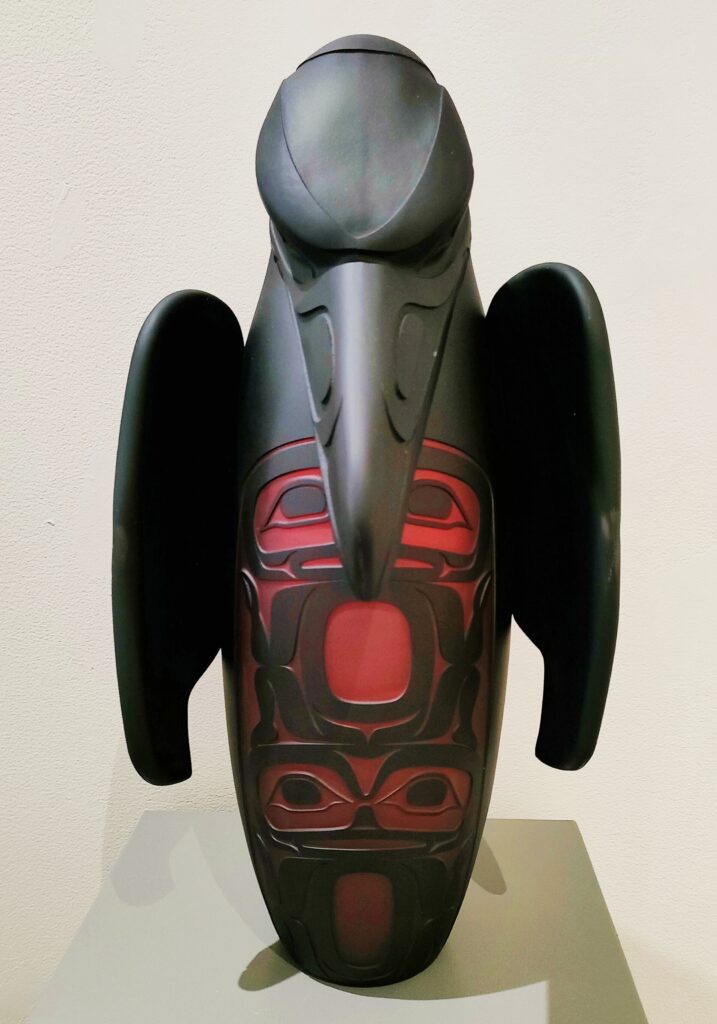
Raven Protects the Children
Blown and Sand Carved Glass 21” H x 11” W x 10″ D
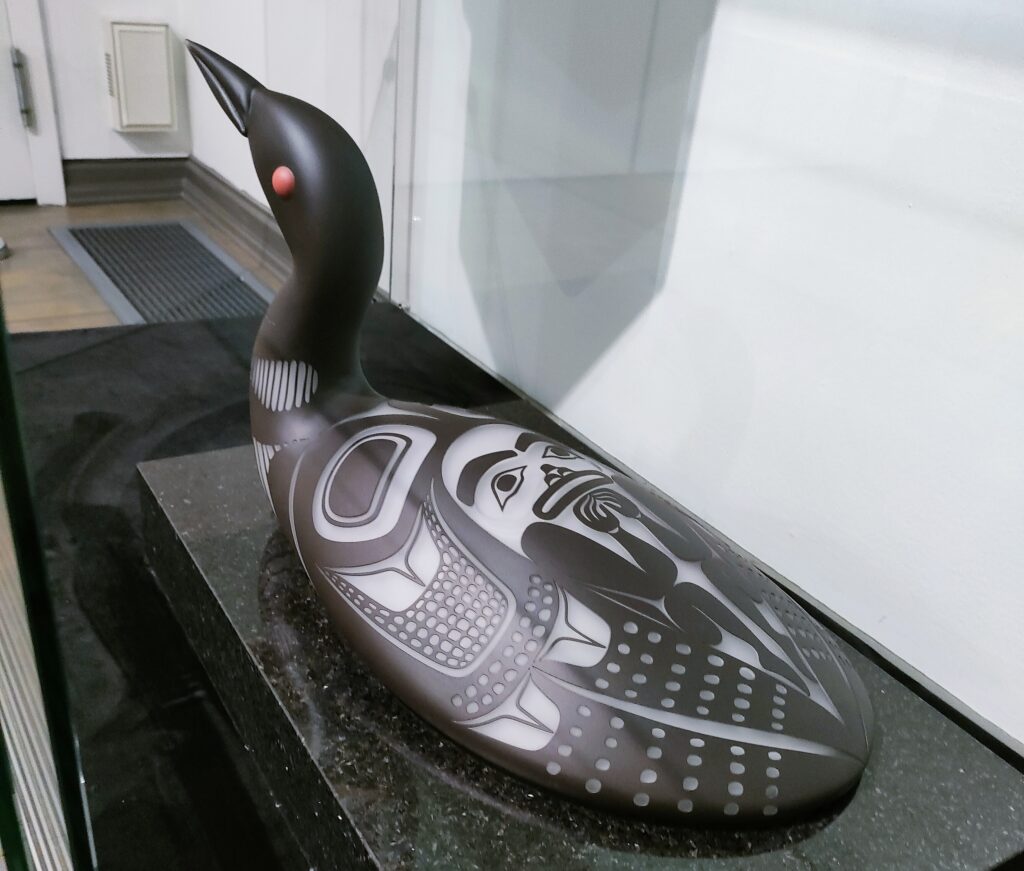
Loon’s Alliance Blown and Sand Carved Glass 10 ¾” H x 19 ½” W x 10″ D
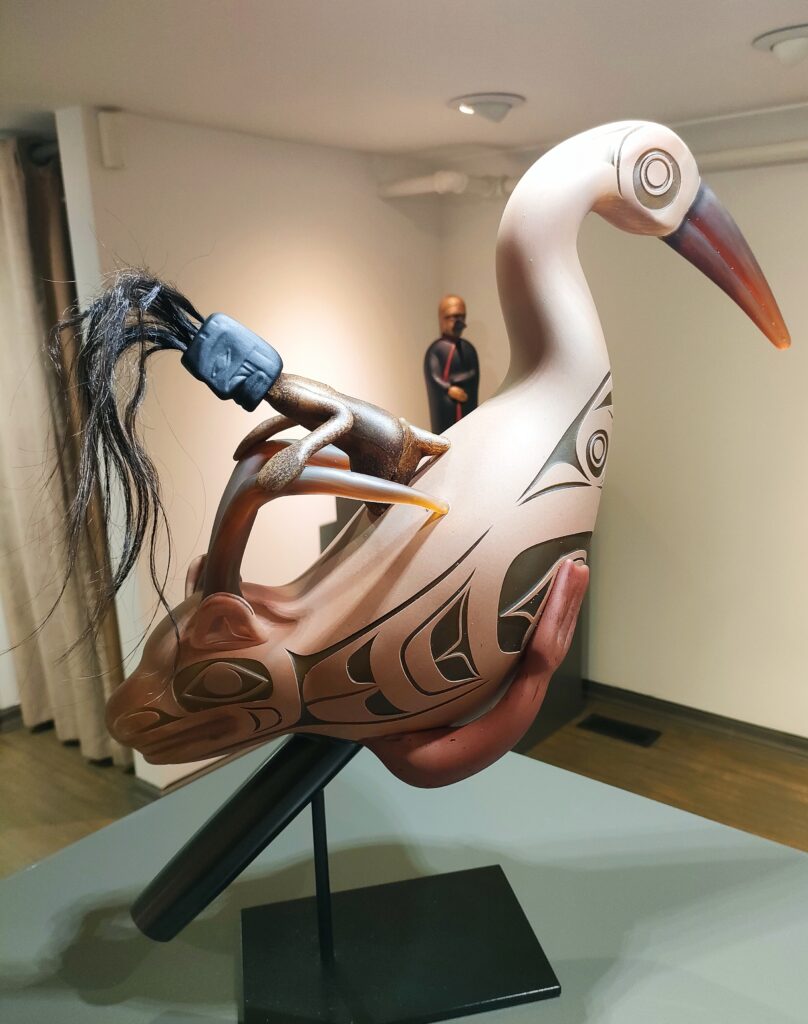
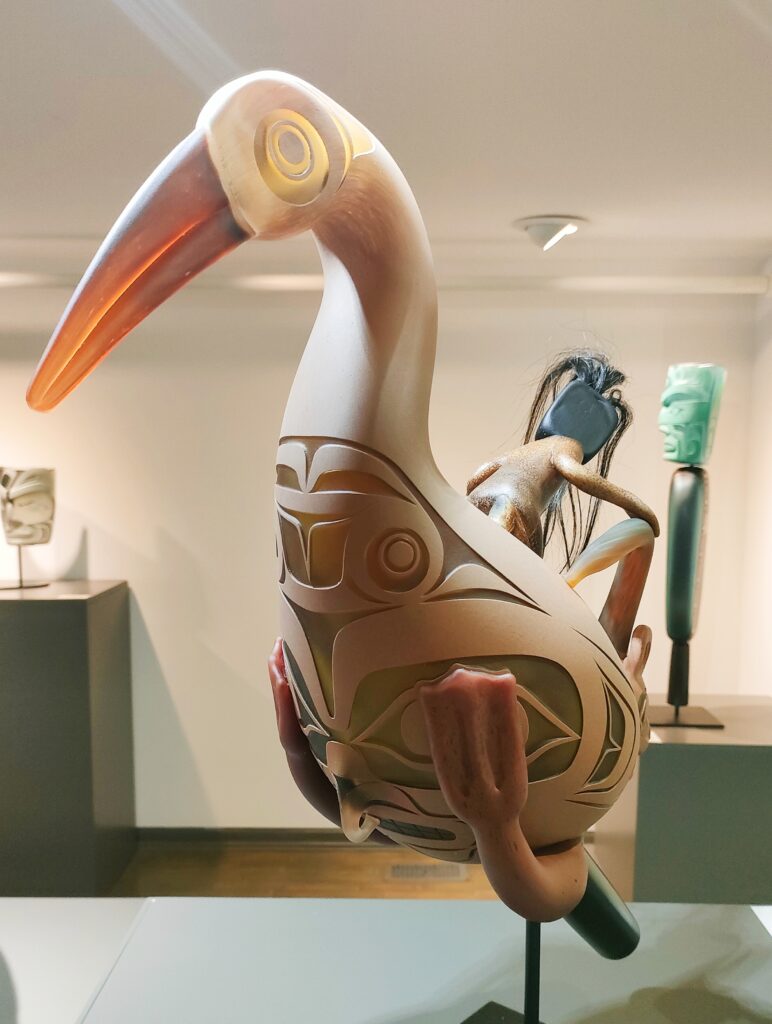
Too Powerful to Look Blown and Sand Carved Glass 22” H x 19” W x 6 ½” D
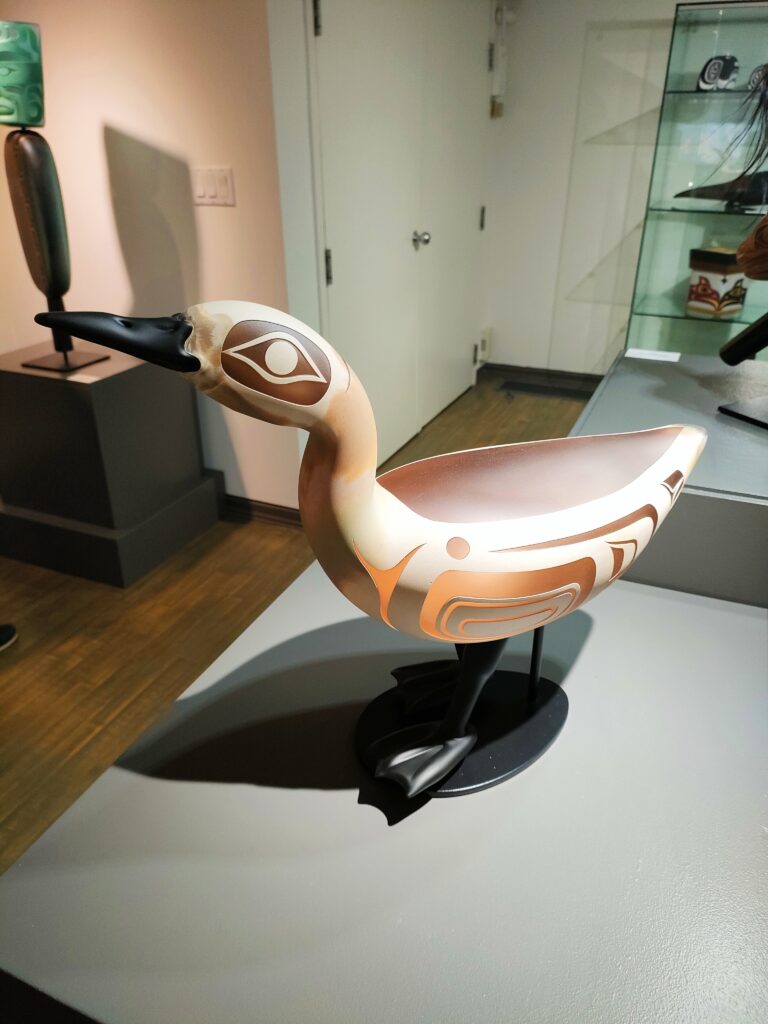
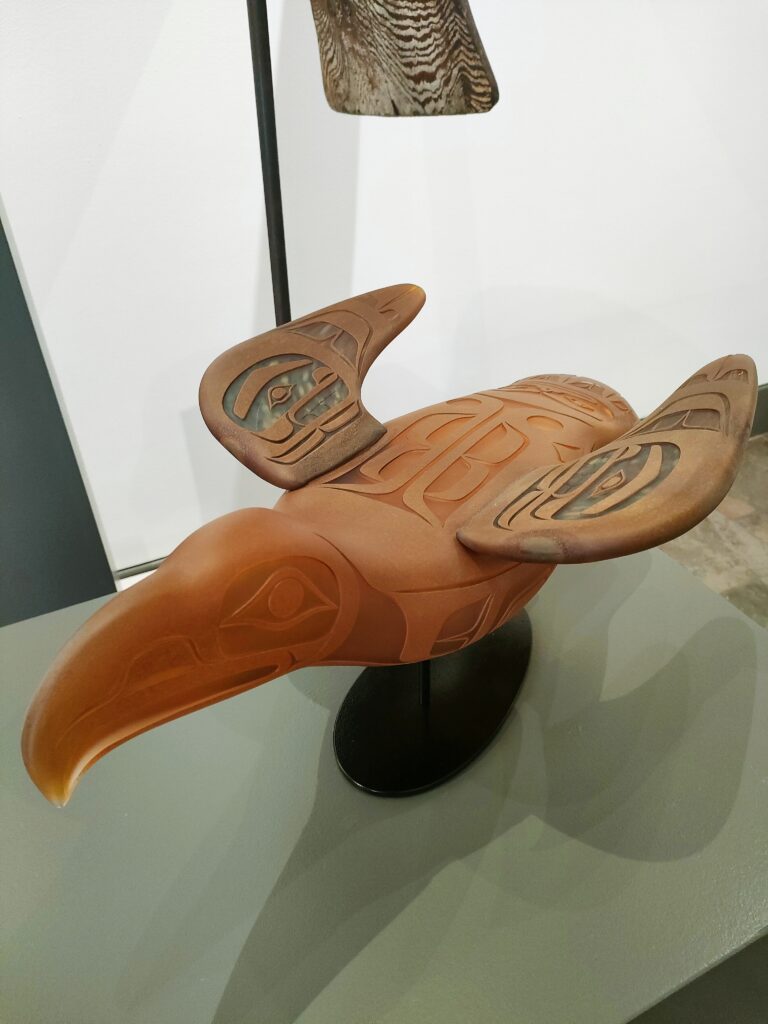
(左)Canadian Goose
Blown and Sand Carved Glass 16 ¾” H x 21″ W x 7″ D
(右)Winged Ones Above
Blown and Sand Carved Glass 12” H x 23″ W x 14″ D
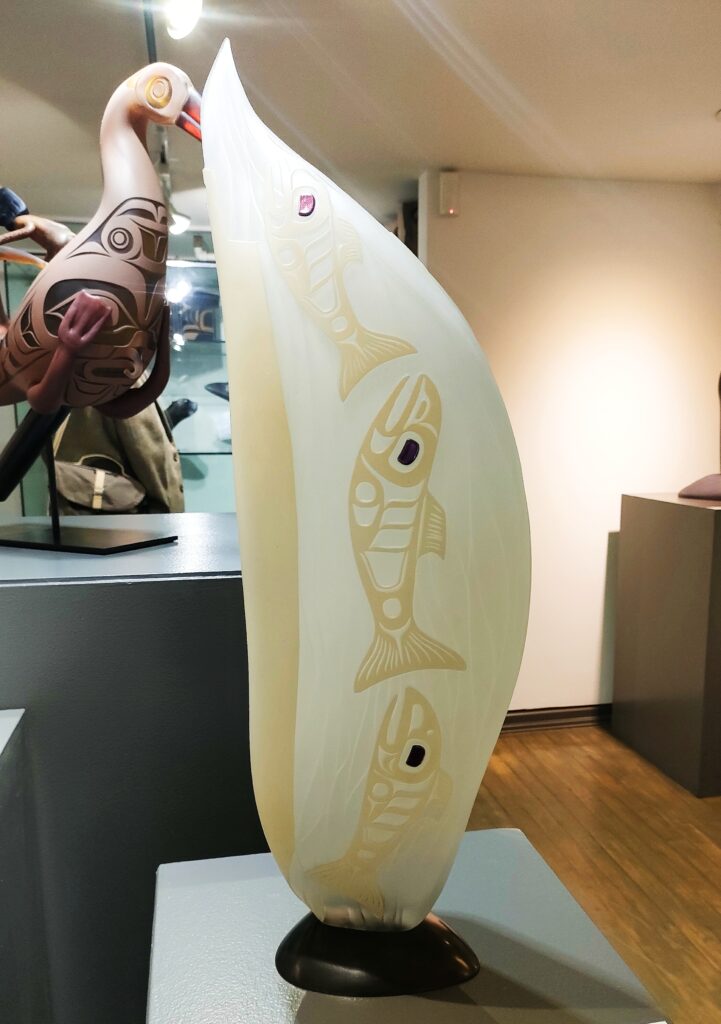

(左)Ghost River
Blown and Sand Carved Glass 26 ½” H x 7 ½” W x 5 ¼” D
(右)Connecting the Cosmos Collaboration with Joe David
Blown and Sand Carved Glass 26 ½” H x 4 ½” W x 12″ D
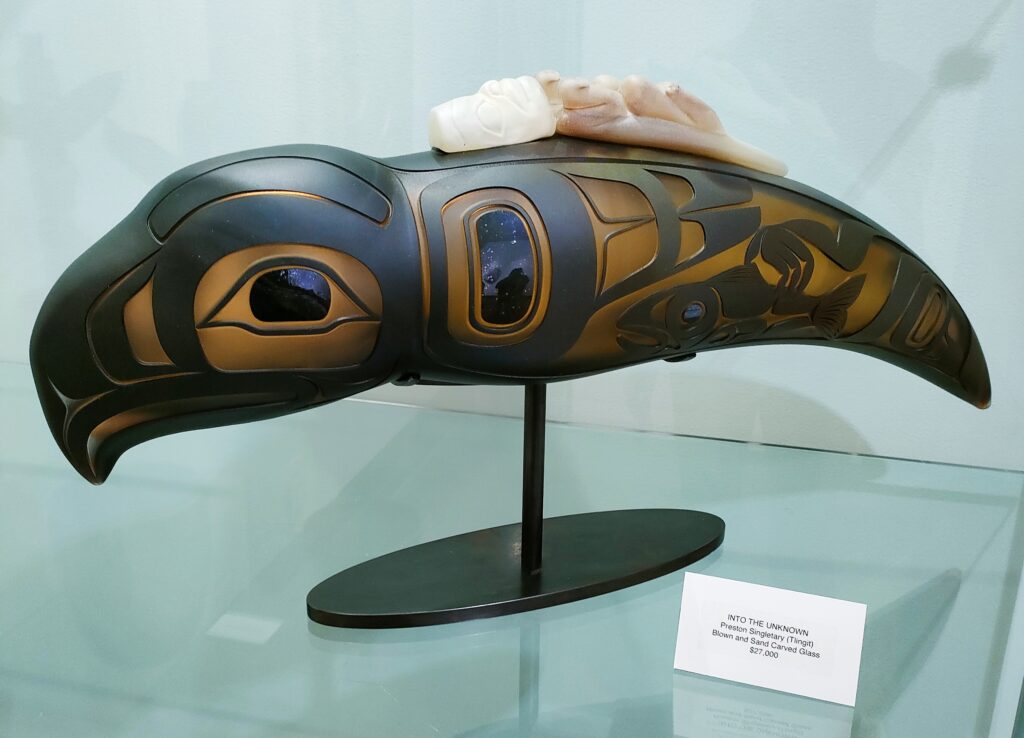
Into the Unknown
Blown and Sand Carved Glass 12” H x 24″ W x 5″ D


Tlingit Basket
Blown and Sand Carved Glass
DOUGLAS REYOLDS GALLERY展覧会パンフレットより引用
バンクーバーでの生活で得る人生の宝
バンクーバーで暮らして約2年が経ちます。この期間での英語スキルの取得や、大切な人々との出会い、現地での仕事の経験は財産です。しかし私にとって現地の伝統的なアートを見たり、アーティストご本人で会える貴重な瞬間も、お金では買えない人生の宝です。
留学や海外生活、ワーキングホリデーに興味はありながらもなかなかその一歩が踏み切れない方。是非こちらの無料エージェントへのご相談からお勧めします。私もそこから全てが始まりました。
キャリアにつながる留学・ワーホリプランを格安でプランニング|夢カナ留学
![]()
海外での生活に挑戦してみたいというぼんやりとしていた希望が明確になり、具体的なプランに変わっていくことでしょう。
プレストン・シングレタリーの数々の賞と栄誉
プレストン・シングレタリーは数多くの賞と栄誉を受賞しています。
コーニング・ミュージアム・オブ・ガラス(NY)からのラコウ・コミッション、ポートランド市(OR)のインディアンアートNWでの多様な芸術に対する市長賞、タコマ大学(WA)からの名誉芸術博士号などが挙げられます。
また国際的に評価されている彼の作品たくさんの美術館に展示されています。
アメリカインディアン国立博物館(ワシントンDC)、美術博物館(ボストン、MA)、ブルックリン美術館(ブルックリン、NY)、シアトル美術館(シアトル、WA)、コーニングガラス美術館(コーニング、NY)、ミント美術館(シャーロット、NC)、ハード美術館(フェニックス、AZ)、ハンデルスバンケン(ストックホルム、スウェーデン)など。
さらに、シングレタリーはピルチャック・グラス・スクールおよびシアトル美術館の理事会のメンバーでもあります。
彼のオフィシャルウェブサイトはこちら→https://www.prestonsingletary.com
参考文献:https://www.craftinamerica.org/artist/preston-singletary/
https://blueraingallery.com/artists/preston-singletary
https://www.arts.wa.gov/artist-collection/?request=record;id=2958;type=701
https://americanindian.si.edu/explore/exhibitions/item?id=976
https://www.americanindianmagazine.org/story/transformations
ノースウェストコーストのアートで使われるシンボルの意味
最後にノースウェストコーストのアートで使われるシンボルの意味の一覧はこちら。非常に興味深い!参考までにこちら貼り付けておきますので興味のある方はご覧ください。
RAVEN 渡り烏 ワタリガラス
世界に光をもたらした創造主。ファーストネーションズ神話における最も重要な文化的なヒーロー(英雄)で、彼らは何事をも可能にしてしまう、ずる賢さを兼ね備えた手品師であり、そのマジックを使い天地創造に関係したと云われています。太陽・月・星を空に、魚を海へ、鮭を川へ、食べ物を陸へ導いたと言われています。レイブンはいたずら好きで、時に自分の姿を変えて人々の前に姿を現します。
THUNDERBIRD 雷鳥 サンダーバード
高貴で全能なる空と超自然界の支配者であり、神秘的、強いスピリット、リーダーシップの象徴です。サンダーバードはインディアンの神話で雷鳴を招き、その目からは稲妻が走ると言われる伝説上の巨鳥であります。
EAGLE 鷲 ワシ
サンダーバードに次ぐ超自然界のスピリットを持つと言われ、偉大な強さ・名声・リーダーシップ・将来の可能性の象徴です。イーグルはとても知力に富み、名高く、他人から尊敬され、リーダーシップに富んでいます。イーグルはこれらの力を使って世界(空)を自由に高く飛びまわります。
EAGLE FEATHER イーグルの羽根
歓迎と友情・平和の象徴。イーグルフェザーは今でもインディアンの儀式の時にゲストの前に撒かれたり、儀式の中でマスクや頭飾りにも使用されました。羽根を手にしている時は、真実を語り、自分に正直でなればいけないとされています。
SUN 太陽 タイヨウ
発展・発達・成長・エネルギー・生命力・治癒能力・昼の地球を見守る者の象徴です。太陽はすべての者の供給者であり、地球や人々にエネルギーまたは生命を与えています。神話では人間の祖先は太陽から変化したと言われています。
MOON 月 ツキ
地球を見守る者・平静や落ち着きの象徴。月はすべての物の守護者であり、特に夜の闇を守るプロテクターです。月は遠くからいつも我々人間を見守り、幸福へと導くと信じられています。
SALMON 鮭 サケ
信頼・繁栄・成功・頼みの綱・再生・供給者・生命を与える者の象徴です。特に通常はペアで彫刻されることが多く、幸運の象徴になっています。
CANADIAN SPIRIT GALLERYサイトより引用
The glass art of the Tlingit artist Preston Singletary, The miracle of encountering him in person
All the photos are located at the top of the article.
Indigenous art of the Pacific Northwest Coast
In Vancouver, what captivates me locally is the Indigenous art of the Pacific Northwest Coast. The ‘Pacific Northwest Region’ refers to the coastal area extending from Northern California through the coastal regions of Canada to the southern part of Alaska. This region is home to various Indigenous peoples, each with its own unique culture, language, and traditions.
The following are some of the major Indigenous groups:
- Coast Salish
- Haida
- Tlingit
- Nuu-chah-nulth
- Nootka
- Kwakwakaʼwakw
- Nuxalk
- Squamish
- Gitxsan
These communities contribute to a rich tapestry of cultures, and their distinctive art forms reflect their deep connection to the land and their heritage.
The glass artist of the Tlingit nation, Preston Singletary
Due to my partner’s job, I am fortunate enough to have opportunities to learn about and directly experience the art of Indigenous artists and communities in the Pacific Northwest region. In this article, we will explore the art of Preston Singletary, the sole glass artist of the Tlingit nation.
The day before Preston’s exhibition began, I visited the gallery and miraculously had the chance to meet him in person. (The photo above captures a scene from the preparation of Preston’s exhibition.)
One of the most distinctive features of his work is the use of the material ‘glass,’ which is entirely unconventional in Northwest Coast arts. Throughout history, Indigenous peoples of the Pacific Northwest Coast have exclusively used natural materials within their surroundings.
In contemporary times, artists in the region use contemporary materials alongside traditional practices. Preston Singletary stands out as the globally acclaimed artist of the Northwest Coast who uses glass to express their traditions, breaking away from the traditional use of materials like red and yellow cedar, abalone and spruce.
The life of Preston Singletary
He was raised in a matrilineal family during his childhood
Preston Singletary (American | Tlingit, born in 1963)
His Great Grandmother was Tlingit, noted in his book “Fusion Notes”
“I was, for the most part, raised by women. My great-grandmother, Susie Johnson Bartlett Gubatayo, centered our family in the Northwest. She was born in Sitka, Alaska, in 1880, at a time of great change. She was arranged in marriage to George Bartlett, who died in a sawmill accident in 1918. Susie had five children with him, including my grandmother. She remarried Dionisio Gubatayo, and moved to Seattle in the 1920s. They had three more children together. All her children lived in the Northwest. Great-Grandma Susie was from the Eagle moiety, Kaagwaantaan Box House, Killer Whale clan of the Tlingit people. That is the lineage that I follow, ours is a matriarchal society.
My grandmother, Lillian Abada, raised my mom Jean Abada and my aunties Andrina Abada and Theresa Sherman pretty much on her own.
My aunt Theresa was quite interested in many esoteric things, including handwriting analysis and numerology. She told me that, based on her numerological analysis of my first, middle, and last name, I was put on this earth, in this life, to learn the meaning of hard work! She also told me when I was 18 that I would travel, and that at the age of 30 my life was going to be forever changed. She was not wrong.
Aunt Andrina was particularly proud of our Alaska Native roots, and was the most vocal about it. The Tlingit way of focused speaking, with intent, is evident in her. I regard her as one of the pillars of our family. Andrina was the mother of my five cousins, and we spent a good deal of time together growing up. We always had fun over the years (one epic road trip to Disneyland with that whole part of the family when I was eight years old was unforgettable).
My grandfather was a cook in the Navy, and I’m told he was gone all the time. I only remember meeting him a few times. He ultimately moved back to the Philippines, and I never saw him again. He passed away in the late 1960s. My grandmother was close to our family, and doted on me. I was almost embarrassed by it sometimes, but you can’t really say that to your grandmother, especially when her family and our tribal connection would eventually become the foundation of my life’s work.” – Preston Singletary.
Fusion Notes
The link for “Fusion Notes” is here: https://minormattersbooks.com/products/fusion-notes-by-preston-singletary.
His official website link is here: https://www.prestonsingletary.com/.
High School to Graduation During high school
Preston Singletary befriended Dante Marioni, the son of glass artist Paul Marioni. Shortly after graduating, while initially pursuing a career as a musician, Preston was asked by Dante Marioni to work as a nighttime security guard at the Glass Eye studio, a glassblowing studio at the time. Preston quickly transitioned from nighttime security to daytime shifts, eventually becoming a member of the studio’s production team.
Over a Decade of Apprenticeship, Prestigious Glass Art School ‘Pilchuck Glass School,’ and Learning Traditional Glass Techniques in Europe
In 1984, Preston attended his first workshop at the ‘Pilchuck Glass School’ in Stanwood, Northwest Washington. Subsequently, he entered the world of glassblowing as an assistant, working alongside glass artists like Dante Marioni.
During this period, he honed his skills by learning traditional techniques in Europe. Working alongside masters of the Italian glass art scene such as Lino Tagliapietra and Pino Signoretto, he also gained expertise in the techniques of Venetian glass artisans.
In the early 1990s, incorporating Tlingit Themes
While honing his skills as a glass artist, in the early 1990s, Singletary began incorporating traditional Tlingit themes into his work, laying the foundation for his current style. Reflecting on his journey, he said, ‘When I started working with glass in 1982, I didn’t anticipate the connection with this material becoming so profound. It was when I began experimenting with the designs of Tlingit culture that my work took on new purpose and direction.’
The skills in form and line design evident in many of Preston’s works were acquired through research and collaboration with prominent artists of the Northwest Coast.
“Among them, he particularly acknowledges the guidance of sculptor Joe David, stating, ‘Joe David’s mentorship, in particular, helped elevate my work to new levels.’ Preston has collaborated with Joe David on numerous works, and the three images above showcase some of their collaborative pieces:
Above:Thunderbird Egg: Blown and Sand Carved Glass, 13″ H x 7″ diam
Bottom Left:Initiation: Blown and Sand Carved Glass, 17 ¾” H x 16″ W x 16″ D
Bottom Left:Water Protector: Blown and Sand Carved Glass, 36 ¾” H x 9″ W x 5 ½” D
He perceives glass as an artistic medium to reconnect with family, community, and cultural roots, visually expressing the stories in which he was raised. ‘Indigenous culture is always evolving, adapting to new materials. Expressing Tlingit designs in glass felt like the next step for me,’ he says.
The artist bridging glassblowing and Northwest Coast art
Preston holds a unique position as a Northwest Coast artist with training exclusively in glass, being considered an artist who bridges a contemporary medium with Northwest Coast design. The Pacific Northwest is known for its strong indigenous visual identity and Seattle residing in the PNW is world renowned for producing some of the best glass artists of the 20th century. Preston blends these two worlds seamlessly in the harmonious execution of his work. He collaborates with many other Indigenous artists interested in glass media, exploring the potential for new directions in glass art.
Through teaching and collaborating with Native American, Hawaiian, and Australian Aboriginal artists in glass, Preston has come to understand how glass can bring a new dimension to Indigenous art. The Indigenous artistic perspective reflects a unique and vital visual language that connects to ancient codes and symbols of the land, influencing and inspiring his work. He expresses hope that his success encourages other underrepresented Indigenous artists to bravely use glass and other non-traditional materials, fostering further innovation in this field as his career progresses.
The Fusion of Modern Art, Glass, and Tlingit Tradition
His works seamlessly blend two elements: glass, Tlingit traditional designs/symbolism and a fusion bridging the two worlds.
Traditional elements and shapes, combined with unconventional, modern Tlingit-inspired colors (rainbow surfaces, internally glowing lights, electric blues, and sea greens), are brought into the contemporary context.
Preston’s mission is to ‘revitalize traditional legends and symbols, tell stories, and create beautiful objects that carry ancient visions into the future.’ His pieces pay homage to his ancestors by injecting new energy into traditional designs using contemporary materials, thus connecting the past, present, and future.
By delving deep into his own story, one can better understand why his works captivate people.
Experiencing Preston Singletary’s Glass Art at an Exhibition
All the photos are located at the top of the article.
Golden Eagle
Blown and Sand Carved Glass 20 ½” H x 14″ W x 11″ D
(Left) Raven and the Box of Daylight
Cast Lead Crystal, 32 ½” H x 8 ½” W x 6″ D
This totem pole is based on the iconic Tlingit story “Raven and the Box of Daylight.” The narrative revolves around Raven bringing light to the once-dark world through the moon, stars, and sun. At the top of the totem pole, there is a mischievous Raven cradling the sun. Below, a prosperous man and his daughter stand atop the box of daylight. The original wooden totem pole was carved by David Franklin.
(Right) Two Ravens Collaboration with Joe David
Cast Lead Crystal, 35 ½” H x 8 ½” W x 9″ D
This totem is a special piece that represents the fusion of Tlingit culture and the Swedish culture of Preston’s wife.
Preston explains, “It symbolizes how we, as a couple, navigate both cultures together, as my wife is from Sweden. We’ve been married for over 25 years, and throughout this extended period, our marital relationship has served as inspiration for my creations. At the top, representing my wife, is a figure, and just below her is the Norse god Odin. In front of Odin, there’s a longship reminiscent of Swedish culture, and in front of that are two ravens. Below Odin, the face of our daughter Lydia is depicted, and beneath her, our son Oro holds our pet owl, symbolized in this sculpture as a wolf.”
“Odin is usually depicted flanked by two ravens. In Tlingit art and culture, ravens hold significant importance. I portrayed Odin as a guiding spirit akin to a shaman in Tlingit culture. This sculpture, carved by one of my mentors, Joe David, embodies the concept I envisioned, designed, and collaborated with David to bring this story to life,” he explains.
Raven Protects the Children Blown and Sand Carved Glass 21” H x 11” W x 10″ D
Loon’s Alliance Blown and Sand Carved Glass 10 ¾” H x 19 ½” W x 10″ D
Too Powerful to Look Blown and Sand Carved Glass 22” H x 19” W x 6 ½” D
Left:Canadian Goose Blown and Sand Carved Glass 16 ¾” H x 21″ W x 7″ D
Right:Winged Ones Above Blown and Sand Carved Glass 12” H x 23″ W x 14″ D
Left:Ghost River Blown and Sand Carved Glass 26 ½” H x 7 ½” W x 5 ¼” D
Right:Connecting the Cosmos Collaboration with Joe David
Blown and Sand Carved Glass 26 ½” H x 4 ½” W x 12″ D
Into the Unknown Blown and Sand Carved Glass 12” H x 24″ W x 5″ D
Tlingit Basket Blown and Sand Carved Glass
Quoted from the DOUGLAS REYOLDS GALLERY exhibition brochure
The numerous awards and honors of Preston Singletary
Preston Singletary has received numerous awards and honors, including the Rakow Commission from the Corning Museum of Glass (NY), the Mayor’s Arts Award for Distinguished Contributions to the Arts from the City of Portland (OR) through Indian Arts NW, and an Honorary Doctorate of Arts from the University of Puget Sound (WA).
His internationally acclaimed works are showcased in various museums, such as the National Museum of the American Indian (Washington, DC), the Museum of Fine Arts (Boston, MA), the Brooklyn Museum (Brooklyn, NY), the Seattle Art Museum (Seattle, WA), the Corning Museum of Glass (Corning, NY), the Mint Museum (Charlotte, NC), the Heard Museum (Phoenix, AZ), and the Handelsbanken (Stockholm, Sweden).
Additionally, Singletary serves as a board member at the Pilchuck Glass School and the Seattle Art Museum.
References: https://www.craftinamerica.org/artist/preston-singletary/
https://blueraingallery.com/artists/preston-singletary
https://www.arts.wa.gov/artist-collection/?request=record;id=2958;type=701
https://americanindian.si.edu/explore/exhibitions/item?id=976
https://www.americanindianmagazine.org/story/transformations
The meaning of symbols used in Northwest Coast art
RAVEN
The creator who brought light to the world. The most important cultural hero in First Nations mythology, Raven is a trickster with the ability to make anything possible. It is said that Raven used its magic in the creation of the heavens and earth, guiding the sun, moon, stars to the sky, fish to the sea, and salmon to the rivers. Raven is mischievous, sometimes appearing in different forms to interact with people.
THUNDERBIRD
A noble and omnipotent ruler of the sky and the supernatural, symbolizing mystery, strong spirit, and leadership. Thunderbird is a legendary giant bird in Indigenous mythology that brings thunder, and lightning is said to flash from its eyes.
EAGLE
Considered to possess a spirit from the supernatural realm, the Eagle is a symbol of great strength, fame, leadership, and future possibilities, second only to the Thunderbird. The Eagle is highly intelligent, renowned, respected by others, and carries a leadership quality. It soars freely in the world (sky) using these powers.
EAGLE FEATHER
A symbol of welcome, friendship, and peace. Eagle feathers are still scattered in front of guests during Indigenous ceremonies, and they have been used in masks and headdresses during rituals. Holding an eagle feather signifies the importance of speaking the truth and being honest with oneself.
SUN
Symbolizing development, growth, energy, life force, healing abilities, and the guardian of the Earth during the day. The sun is the provider for all beings, giving energy or life to the Earth and its inhabitants. In mythology, it is said that human ancestors transformed from the sun.
MOON
Guardian of the Earth, symbolizing serenity and calmness. The moon is considered the protector of all things, particularly safeguarding the darkness of the night. It is believed that the moon watches over humans from afar, guiding them towards happiness.
SALMON
Symbolizing trust, prosperity, success, a lifeline, regeneration, provider, and giver of life. Often carved in pairs, salmon are seen as symbols of good luck.
Quoted from the Canadian Spirit Gallery website

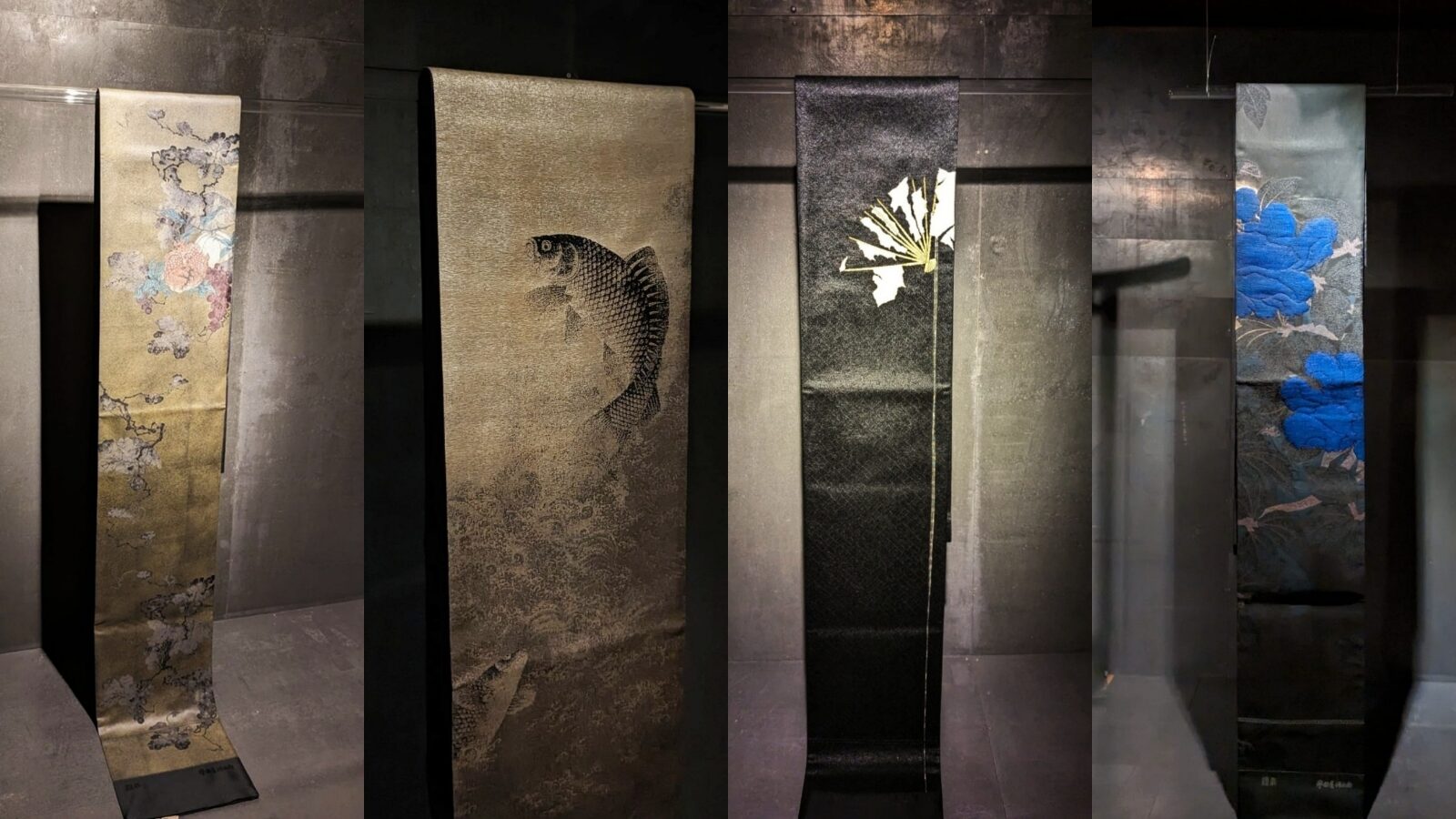
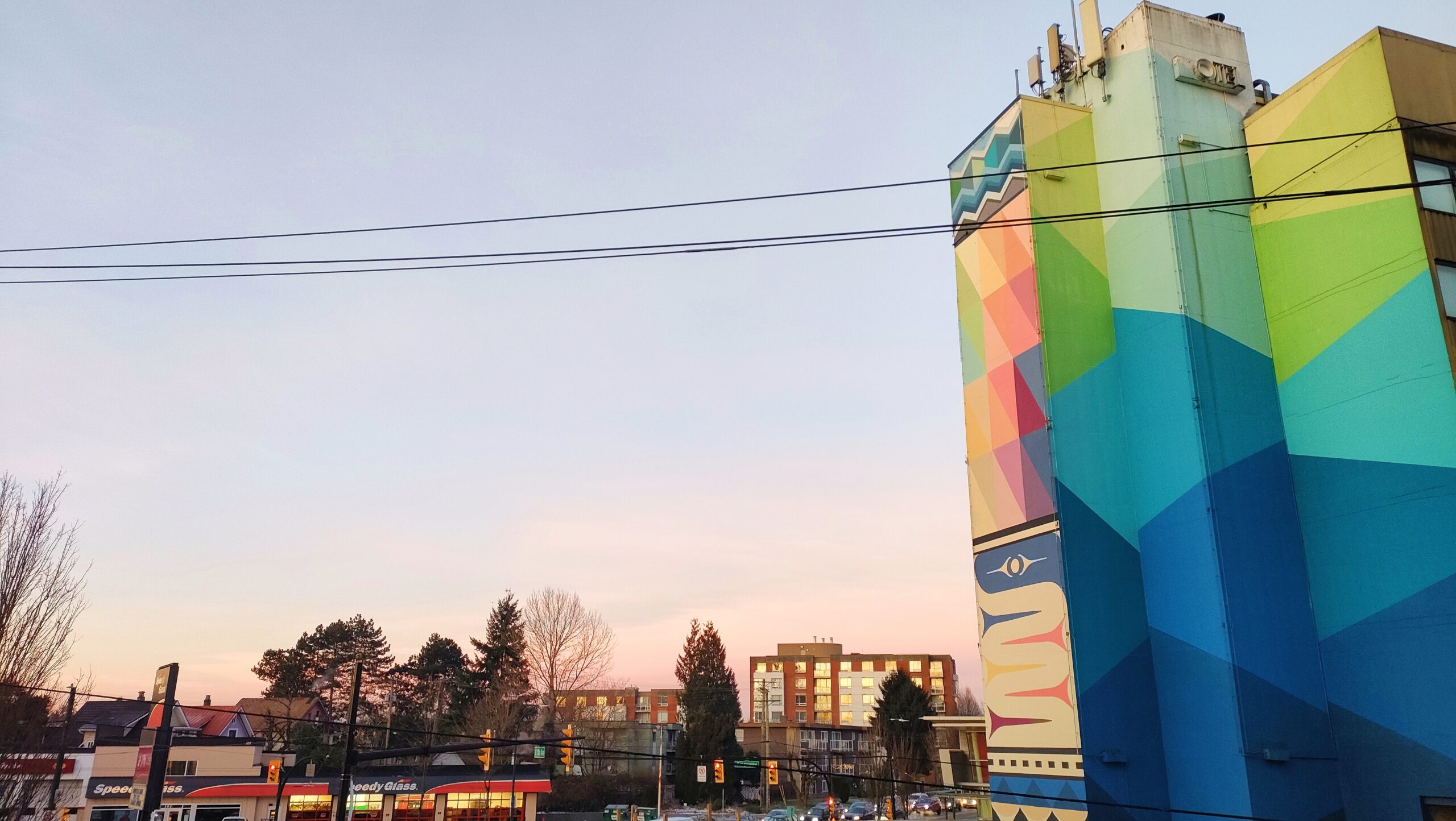
コメント